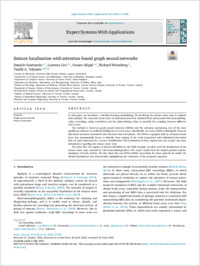Seizure localisation with attention-based graph neural networks
- Grattarola, Daniele ORCID Facoltà di scienze informatiche, Università della Svizzera italiana, Svizzera
- Livi, Lorenzo ORCID Departments of Computer Science and Mathematics, University of Manitoba, Winnipeg, Canada - Department of Computer Science, University of Exeter, Exeter, United Kingdom
- Alippi, Cesare ORCID Facoltà di scienze informatiche, Università della Svizzera italiana, Svizzera - Department of Electronics, Information, and Bioengineering, Politecnico di Milano, Milan, Italy
- Wennberg, Richard Division of Neurology, Department of Medicine, Krembil Brain Institute, Toronto Western Hospital, University of Toronto, Toronto, Canada
- Valiante, Taufik A. ORCID Department of Surgery, Division of Neurosurgery, University of Toronto, Toronto, Canada - Krembil Brain Institute, Division of Clinical and Computational Neuroscience, Toronto, Canada - Institute of Medical Sciences, University of Toronto, Toronto, Canada - Institute of Biomedical Engineering, University of Toronto, Toronto, Canada - Electrical and Computer Engineering, University of Toronto, Toronto, Canada
- 2022
Published in:
- Expert systems with applications. - 2022, vol. 203, p. 117330
English
In this paper, we introduce a machine learning methodology for localising the seizure onset zone in subjects with epilepsy. We represent brain states as functional networks obtained from intracranial electroencephalography recordings, using correlation and the phase-locking value to quantify the coupling between different brain areas.
Our method is based on graph neural networks (GNNs) and the attention mechanism, two of the most significant advances in artificial intelligence in recent years. Specifically, we train a GNN to distinguish between functional networks associated with interictal and ictal phases. The GNN is equipped with an attention-based layer that automatically learns to identify those regions of the brain (associated with individual electrodes) that are most important for a correct classification. The localisation of these regions does not require any prior information regarding the seizure onset zone.
We show that the regions of interest identified by the GNN strongly correlate with the localisation of the seizure onset zone reported by electroencephalographers. We report results both for human patients and for simulators of brain activity. We also show that our GNN exhibits uncertainty for those patients for which the clinical localisation was unsuccessful, highlighting the robustness of the proposed approach.
Our method is based on graph neural networks (GNNs) and the attention mechanism, two of the most significant advances in artificial intelligence in recent years. Specifically, we train a GNN to distinguish between functional networks associated with interictal and ictal phases. The GNN is equipped with an attention-based layer that automatically learns to identify those regions of the brain (associated with individual electrodes) that are most important for a correct classification. The localisation of these regions does not require any prior information regarding the seizure onset zone.
We show that the regions of interest identified by the GNN strongly correlate with the localisation of the seizure onset zone reported by electroencephalographers. We report results both for human patients and for simulators of brain activity. We also show that our GNN exhibits uncertainty for those patients for which the clinical localisation was unsuccessful, highlighting the robustness of the proposed approach.
- Collections
- Language
-
- English
- Classification
- Computer science and technology
- License
- Open access status
- hybrid
- Identifiers
-
- DOI 10.1016/j.eswa.2022.117330
- ARK ark:/12658/srd1324963
- Persistent URL
- https://n2t.net/ark:/12658/srd1324963
Statistics
Document views: 119
File downloads:
- Grattarola_2022_Else_eswa: 196
